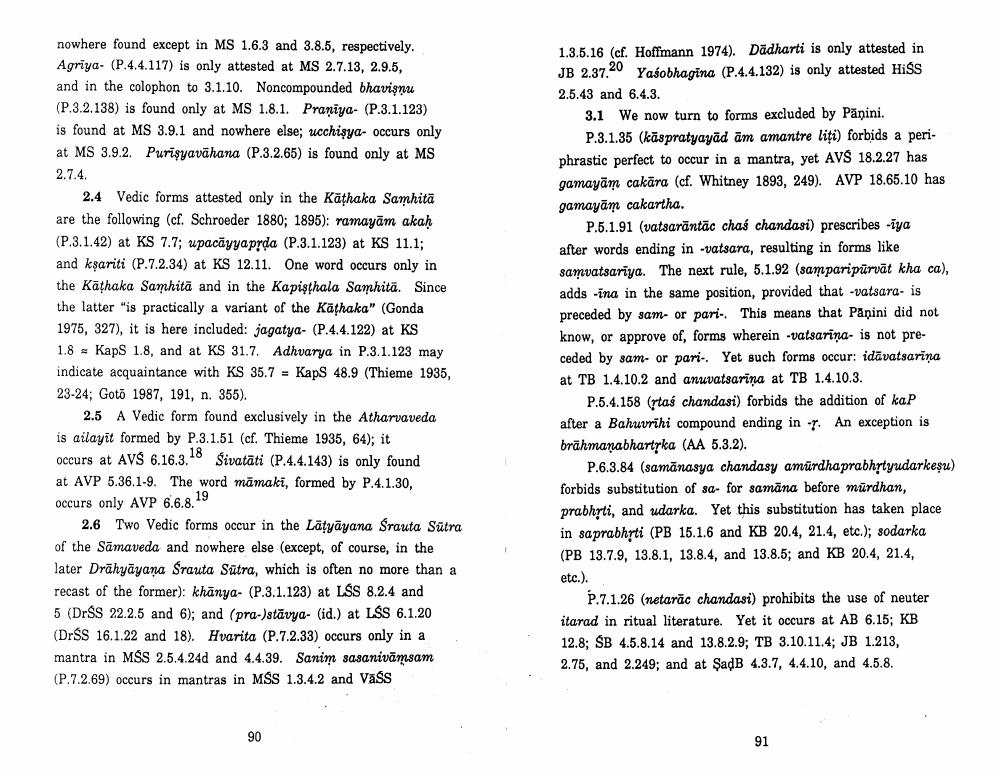Book Title: Paninian And Veda Reconsidered Author(s): Johannes Bronkhorst Publisher: Johannes Bronkhorst View full book textPage 9
________________ nowhere found except in MS 1.6.3 and 3.8.5, respectively. Agriya. (P.4.4.117) is only attested at MS 2.7.13, 2.9.5, and in the colophon to 3.1.10. Noncompounded bhavienu (P.3.2.138) is found only at MS 1.8.1. Praniya- (P.3.1.123) is found at MS 3.9.1 and nowhere else; ucchişya- occurs only at MS 3.9.2. Purişyavāhana (P.3.2.65) is found only at MS 2.7.4. 2.4 Vedic forms attested only in the Kathaka Samhita are the following (cf. Schroeder 1880; 1895): ramayām akah (P.3.1.42) at KS 7.7; upacayyaprda (P.3.1.123) at KS 11.1; and kşariti (P.7.2.34) at KS 12.11. One word occurs only in the Käthaka Samhita and in the Kapisthala Samhitä. Since the latter "is practically a variant of the Kathaka" (Gonda 1975, 327), it is here included: jagatya- (P.4.4.122) at KS 1.8 - Kaps 1.8, and at KS 31.7. Adhvarya in P.3.1.123 may indicate acquaintance with KS 35.7 = Kaps 48.9 (Thieme 1935, 23-24; Goto 1987, 191, n. 355). 2.5 A Vedic form found exclusively in the Atharvaveda is ailayit formed by P.3.1.51 (cf. Thieme 1935, 64); it occurs at AVS 6.16.3. Sivatāti (P.4.4.143) is only found at AVP 5.36.1-9. The word māmaki, formed by P.4.1.30, occurs only AVP 6.6.8.19 2.6 Two Vedic forms occur in the Latyāyana Srauta Sutra of the Samaveda and nowhere else (except, of course, in the later Drähyäyana Srauta Sūtra, which is often no more than a recast of the former): khânya- (P.3.1.123) at LSS 8.2.4 and 5 (DrSS 22.2.5 and 6); and (pra-)stāvya. (id.) at LSS 6.1.20 (DrŚS 16.1.22 and 18). Hvarita (P.7.2.33) occurs only in a mantra in MSS 2.5.4.24d and 4.4.39. Sanim sasanivamsam (P.7.2.69) occurs in mantras in MSS 1.3.4.2 and Vass 1.3.5.16 (cf. Hoffmann 1974). Dādharti is only attested in JB 2.37.20 Yasobhagina (P.4.4.132) is only attested Hiss 2.5.43 and 6.4.3. 3.1 We now turn to forms excluded by Panini. P.3.1.35 (kaspratyayād am amantre liți) forbids a periphrastic perfect to occur in a mantra, yet AVS 18.2.27 has gamayām cakāra (cf. Whitney 1893, 249). AVP 18.65.10 has gamayām cakartha. P.5.1.91 (vatsaräntäc chas chandasi) prescribes -iya after words ending in vatsara, resulting in forms like samvatsariya. The next rule, 5.1.92 (samparipūrvät kha ca), adds -ina in the same position, provided that vatsara.is preceded by sam- or pari. This means that Panini did not know, or approve of, forms wherein vatsarina is not preceded by sam- or pari.. Yet such forms occur: idāvatsarina at TB 1.4.10.2 and anuvatsarina at TB 1.4.10.3. P.5.4.158 (tas chandasi) forbids the addition of kap after a Bahuvrihi compound ending in . An exception is brahmanabhartyka (AA 5.3.2). P.6.3.84 (samānasya chandasy amūrdhaprabhytyudarkeşu) forbids substitution of sa- for samāna before mürdhan, prabhyti, and udarka. Yet this substitution has taken place in saprabhyti (PB 15.1.6 and KB 20.4, 21.4, etc.); sodarka (PB 13.7.9, 13.8.1, 13.8.4, and 13.8.5; and KB 20.4, 21.4, etc.). P.7.1.26 (netarac chandasi) prohibits the use of neuter itarad in ritual literature. Yet it occurs at AB 6.15; KB 12.8; SB 4.5.8.14 and 13.8.2.9; TB 3.10.11.4; JB 1.213, 2.75, and 2.249; and at SadB 4.3.7, 4.4.10, and 4.5.8. 90Page Navigation
1 ... 7 8 9 10 11 12 13 14 15 16 17 18 19 20 21 22 23 24
